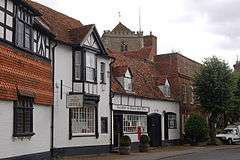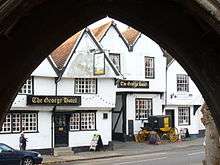Dorchester on Thames
| Dorchester on Thames | |
 Dorchester with the abbey tower in the background |
|
 Dorchester on Thames |
|
| Area | 4.18 km2 (1.61 sq mi) |
|---|---|
| Population | 992 (2001 census)[1] |
| – density | 237/km2 (610/sq mi) |
| OS grid reference | SU5794 |
| Civil parish | Dorchester |
| District | South Oxfordshire |
| Shire county | Oxfordshire |
| Region | South East |
| Country | England |
| Sovereign state | United Kingdom |
| Post town | Wallingford |
| Postcode district | OX10 |
| Dialling code | 01865 |
| Police | Thames Valley |
| Fire | Oxfordshire |
| Ambulance | South Central |
| EU Parliament | South East England |
| UK Parliament | Henley |
| Website | Dorchester on Thames |
|
|
Coordinates: 51°38′38″N 1°09′58″W / 51.644°N 1.166°W
Dorchester on Thames (or Dorchester-on-Thames) is a village and civil parish in Oxfordshire, about 3 miles (5 km) northwest of Wallingford and 8 miles (13 km) southeast of Oxford. The town is a few hundred yards from confluence of the River Thames and River Thame.
Historically the Thames was only so named downstream of the village; upstream it is named the Isis, and Ordnance Survey maps continue to label the river as "River Thames or Isis" above Dorchester. In practice, however, this distinction is rarely made outside the city of Oxford.
History
The area has been inhabited since at least the Neolithic. In the north of the parish there was a Neolithic sacred site, now largely destroyed by gravel pits. On one of the Sinodun Hills on the opposite side of the Thames, a ramparted settlement was inhabited during the Bronze Age and Iron Age. Two of the Sinodun Hills bear distinctive landmarks of mature trees called Wittenham Clumps. Adjacent to the village is Dyke Hills which is the remains of an Iron Age hill fort.
Dorchester's position close to the navigable Thames and bounded on three sides by water made it strategic for both communications and defence. The Romans built a vicus[2] here, with a road linking the settlement to a military camp at Alchester, 16 miles (25 km) to the north.[3] The settlement's Roman name is unclear; back-formations from Bede's Dorcic are unsupported.[4]
In 634 Pope Honorius I sent a bishop called Birinus to convert the Saxons of the Thames Valley to Christianity. King Cynegils of Wessex gave Dorchester to Birinus as the seat of a new Diocese of Dorchester under a Bishop of Dorchester; the diocese was extremely large, and covered most of Wessex and Mercia. The settled nature of the bishopric made Dorchester in a sense the de facto capital of Wessex, which was later to become the dominant kingdom in England; eventually Winchester displaced it, with the bishopric being transferred there in 660. Briefly in the late 670s Dorchester was once more a bishop's seat under Mercian control.[5]
Dorchester again became the seat of a bishop in around 875, when the Mercian Bishop of Leicester transferred his seat there. The diocese merged with that of Lindsey in 971; the bishop's seat was moved to Lincoln in 1072.
In the 12th century the church was enlarged to serve a community of Augustinian canons. King Henry VIII dissolved this Catholic Abbey in 1536, leaving a small village with a huge new Church of England parish church.
Amenities

Dorchester Abbey[6] is both the village's Church of England parish church and its main tourist attraction. The Abbey has a museum.
Of the ten original coaching inns, two remain: The George[7] and The White Hart. The George has a galleried yard dating back to 1495 and it used to serve coaches on the Gloucester-Oxford-London route. The George was used as a filming location for ITV's Agatha Christie's Poirot in the episode Taken at the Flood in 2006.[8]
Festivals and events
Dorchester on Thames is the home of a number of annual events:
- The biennial Dorchester on Thames Festival, a 10-day fundraising event held every other May[9]
- The English Music Festival[10]
Nearby is Day's Lock on the Thames, where an annual "World Poohsticks Championship" is held.
Notable people from Dorchester
- Jonty Hearnden - antiques expert and television presenter
- Mark Wright - footballer and former England captain
- Tom Penny - professional skateboarder
References
- ↑ "Area: Dorchester CP (Parish): Parish Headcounts". Neighbourhood Statistics. Office for National Statistics. Retrieved 16 March 2010.
- ↑ "No definite public or administrative buildings have yet been excavated" note Barry C. Burnham and J. S. Wacher, The Small Towns of Roman Britain 1990: "Dorchester on Thames" p. 337
- ↑ Togodumnus (Kevan White). "DORCHESTER ON THAMES". Roman-britain.org. Retrieved 25 December 2014.
- ↑ Barry C. Burnham and J. S. Wacher, The Small Towns of Roman Britain "Dorchester on Thames"
- ↑ Kirby Earliest English Kings p. 48-49
- ↑ "Welcome". Dorchester-abbey.org.uk. Retrieved 25 December 2014.
- ↑ "The George Hotel, Doirchester : Webpage". Georgehotel-dorchester.co.uk. Retrieved 25 December 2014.
- ↑ "Poirot Locations - Taken at the Flood". Tvlocations.net. Retrieved 25 December 2014.
- ↑ "Dorchester-on-Thames Festival - Fun for all the family". Dorchesterfestival.com. Retrieved 25 December 2014.
- ↑ "Welcome to The English Music Festival". Englishmusicfestival.org.uk. Retrieved 25 December 2014.
Sources
- Aston, Michael; Bond, James (1976). The Landscape of Towns. Archaeology in the Field Series. London: J.M. Dent & Sons Ltd. pp. 47, 52, 61, 62, 64. ISBN 0-460-04194-0.
- Kirby, D. P. (2000). The Earliest English Kings. New York: Routledge. ISBN 0-415-24211-8.
- Lobel, Mary D, ed. (1962). A History of the County of Oxford: Volume 7: Thame and Dorchester Hundreds. Victoria County History. pp. 39–64.
- Sherwood, Jennifer; Pevsner, Nikolaus (1974). Oxfordshire. The Buildings of England. Harmondsworth: Penguin Books. pp. 576–586. ISBN 0-14-071045-0.
- Tiller, Kate, ed. (2005). Dorchester Abbey: Church and People 635–2005. Stonesfield Press. ISBN 0-9527126-4-4.
External links
| Wikimedia Commons has media related to Dorchester-on-Thames. |

